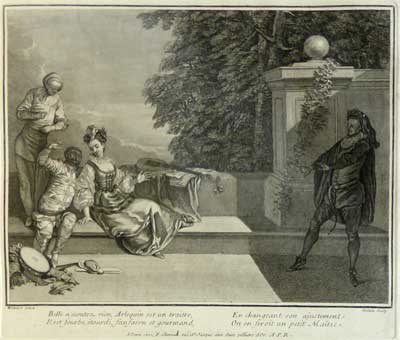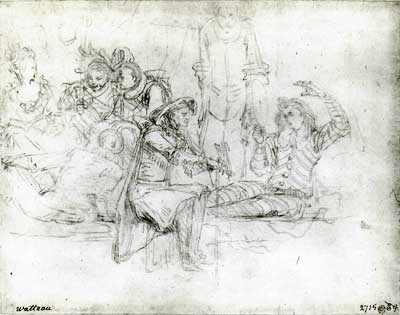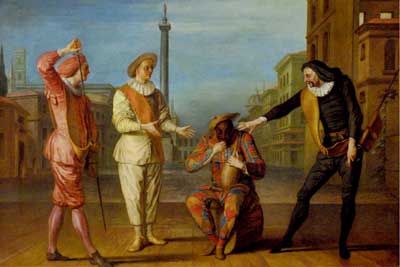
- Home Page
- Accepted
Paintings & Copies - Doubtful
Attributions - Doubtful Textual References
- Alternative
Titles - Collectors &
Museums - Bibliography
- Search Abecedario
- Watteau &
His Circle
Belle n'écoutez rien
Entered April 2016; revised September 2016
Presumed lost
Oil on panel
Approximately 20 x 26.5 cm
ALTERNATIVE TITLES
Arlequin amoureux
Belles n’écoutez rien
Le Plaisir d’Arlequin
RELATED PRINTS

Watteau’s painting Belle n’écoutez rien and its pendant, Pour garder l’honneur d’une belle, were engraved by Charles Nicolas Cochin in the same sense as the original pictures. Below each image is a quatrain. In the former instance, the first line of the poem begins “Belle n’écoutez rien,” thus giving rise to the title in common use. These engravings belong to a group issued before 1729 by Watteau’s friend, the dealer Pierre Sirois, a group then taken over by Jean de Jullienne. The print and its pendant were described together by Mariette, Notes manuscrites, fol. 191: “Deux sujets de Scenes du Theatre Italien, l’un represente Arlequin amoreux, l’autre le Docteur trouvant sa fille en teste-à-teste avec son amant; ils sont graves l’un & l’autre par Charles Nicolas Cochin.”
Dacier, Vuaflart, and Hérold cite four other prints, all apparently based on the one by Cochin and in reverse of Cochin’s.
PROVENANCE
The engraving does not cite the original owner of the painting, and it has not been possible to trace the picture or its pendant, Pour garder l’honneur d’une belle, in eighteenth-century documents save for the two following possible references, neither of which has previously been identified with the paintings and neither of which has a firm association.
Paris, collection of Jeanne Baptiste d'Albert de Luynes, comtesse de Verrue (1670-1736). Her sale, Paris, March 27ff, 1737 [without lot numbers]: “Deux Tableaux de Gillot ou Vatteau”. The indecision regarding an attribution of the comtesse de Verrue’s paintings to either Watteau or Gillot is remarkable, especially since both artists had died just fifteen years earlier and the paintings had been engraved under Watteau’s name probably within the last five years. Yet, of all the paintings in Watteau’s oeuvre, none would better reflect this quandary than Belle n’écoutez rien and Pour garder l’honneur d’une belle.
Paris, collection of Jean Corneille Landgraff (d. after 1790; jeweler). His sale, Paris, December 21ff, 1784, lot 25: “A. Watteau. . . . Deux Tableaux, représentant des compagnies d’hommes & de femmes dans des Jardins: dans l’un on remarque un grouppe de figures, occupés à faire de la musique; dans l’autre, pour principal personage, une jeune Dame & un homme sous un habillement de Pierrot. Ces deux Tableaux sont chauds de couleur & gracieux pour leur composition. Haut. 9 pouc., larg. 11 pouces & demi. B.” Sold for 402 livres the pair to the dealer Saubert. Although the descriptions of the pictures are frustratingly generic, the measurements of 9 x 11 pouces (22.9 x 27.9 cm) are close to but do not correspond exactly to what we believe the actual measurements of the painting should be (20 x 26.5 cm). Thus, a provenance from Landgraff remains only a tantalizing possibility.
SELECT BIBLIOGRAPHY
Mariette, "Notes manuscrites," 9: fol. 191.
Goncourt, Catalogue raisonné (1875), cat. 76.
Zimmerman, Watteau (1912), 13.
Dacier, Vuaflart, and Hérold, Jean de Jullienne et les graveurs (1921-29), 2: 4; 3: cat. 82.
Réau, “Watteau” (1928), cat. 62.
Adhémar, Watteau (1950), cat. 43.
Mathey, Watteau, peintures réapparues (1959), 66.
Macchia and Montagni, L’opera completa di Watteau (1968), cat. 16.
Ferré, Watteau (1972), cat. B9.
Posner, Watteau (1984), 53.
Roland Michel, Watteau (1984), 176-77, 291.
Brussels, Palais des beaux-arts, Watteau, Leçon de musique (2013), cat. 33.
RELATED DRAWINGS
There are no Watteau drawings from the model that can be associated directly with Belle n’écoutez rien.

Watteau, Compositional Study with Commedia dell’arte characters, sanguine counterproof, 16.5 x 21.5 cm. Stockholm, Nationalmuseum.
On the other hand, an early Watteau compositional study offers interesting parallels with the painting, but it is known through a counterproof acquired from the artist by Count Tessin in 1715 (Rosenberg and Prat 92). Although the resemblance between Watteau’s painting and the Stockholm counterproof has been noted in the past, Rosenberg and Prat dismiss its significance. As in the painting, a few random lines in the drawing suggest a horizontal ledge and all the actors sit or stand on the raised platform as in Belle n’écoutez rien. Also, the standing Pierrot stares forward, with just a suggestion of looking to the characters in front of him, and his sleeves are puffed into a series of folds at his elbows—all as in Watteau’s painting. (This formula for Pierrot’s appearance occurs in Watteau’s later paintings such as La Troupe italienne, Les Comédiens italiens, and Gilles.)
REMARKS
The quatrain beneath the engraving of Belle n’écoutez rien reads as follows:
Belle n’écoutez rien, Arlequin est un traitre,
Il est fourbe, étourdi, fanfaron et gourmand
En changeant son ajustement,
On en feroit un petit Maitre.Beautiful girl, don’t listen to anything, Harlequin is a traitor.
He is disingenuous, dizzy, a braggart, and gluttonous
By changing his costume,
He can appear like a small master.
Thus, in the eyes of Watteau’s contemporaries, Watteau’s theatrical scene portrays Harlequin wooing the innocent actress (perhaps Isabelle, Colombine, or any of the other young actresses) when Dr. Baloardo enters from the side and warns the unsuspecting girl to be wary of Harlequin’s advances.
Scholars agree that this picture and its pendant are wholly in the style of Gillot’s theatrical scenes such as Le Tombeau de maître André and Les Deux carosses. The characters occupy a shallow foreground stage and the background is just that—a theatrical drop they cannot enter. Watteau’s actors are not in a landscape but appear before the representation of one. Only later in his career, as in Voulez-vous triompher des belles?, will Watteau confound us with the illusion that the characters are in a real garden.
Gillot’s theatrical narrative, as well as Watteau’s in Belle n’écoutez rien, is factual and documentary. Not only is the theatrical setting explicit, but so too is the narrative. We can read Watteau's script: Harlequin has cunningly been wooing Colombine, when suddenly Dr. Baloardo enters, finds them in too close proximity, and warns the unwitting girl to be wary of Harlequin’s advances. Whereas this picture waits to be linked to a specific scene within a specific play, the artist’s later paintings are much more equivocal in terms of their narrative content.
Watteau’s closeness to Gillot’s manner has implications, of course, for the dating of the painting. While scholars agree that these two pendants are from the early part of Watteau’s career, there is little accord as to exactly when Watteau worked with Gillot and when these pendants were executed. Mathey would date them c. 1704-05, Roland Michel c. 1706-08, Adhémar c. 1710-11, Posner c. 1712. These many stabs at dating the works only emphasize how uncertain and subjective the chronology of his early career is.
For copies of Belle n'écoutez rien CLICK HERE
